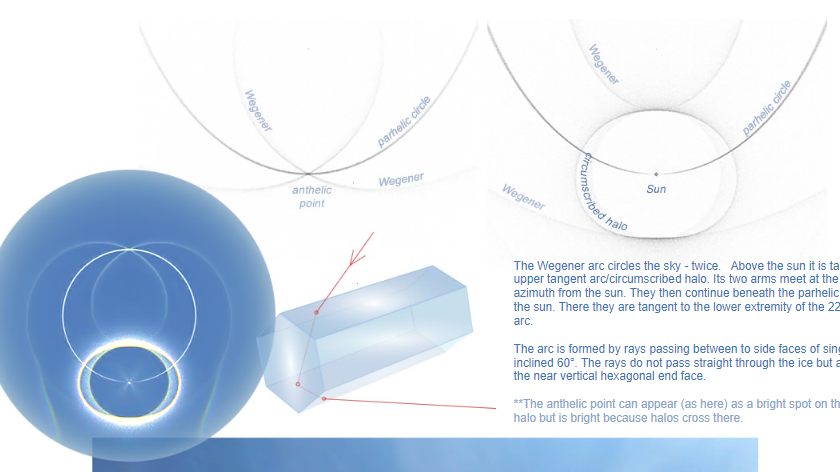Wegener Arc, Delft, The Netherlands - OPOD
The Rare and Captivating Wegener Arc in Delft, The Netherlands
In the enchanting city of Delft, located in the Netherlands, a stunning atmospheric phenomenon known as the Wegener Arc occasionally graces the sky. This rare optical display is characterized by a faint halo forming a cross near the tip of the spire of the Nieuwe Kerk, complementing the bright arc that is part of the parhelic circle. The Wegener Arc, named after the German meteorologist Alfred Wegener, adds a touch of mystique to the atmospheric optics experienced in Delft.
The Wegener Arc's Fascinating Journey Across the Sky
Unlike most halos that form singular circles around the sun, the Wegener Arc takes a unique path across the sky. It circles the sky twice, with its arms meeting at the anthelic point, which is located 180° in azimuth from the sun. Above the sun, it is tangent to the 22° halo and upper tangent arc, while below the sun, it is tangent to the lower extremity of the 22° halo and lower tangent arc. The arc's ethereal journey beneath the parhelic circle adds to its allure and intrigue.
Unveiling the Formation of the Wegener Arc
The Wegener Arc owes its existence to the interaction between sunlight and ice crystals present in the atmosphere. Rays of sunlight pass between two side faces of singly oriented columns that are inclined at an angle of 60°. Rather than passing straight through the ice, these rays undergo internal reflection from the near-vertical hexagonal end face of the ice crystals. This intricate process ultimately gives birth to the mesmerizing Wegener Arc.
Discovering the Anthelic Point's Role in Wegener Arc Observations
One notable feature associated with the Wegener Arc is the anthelic point, which often appears as a bright spot on the parhelic circle. It is essential to note that the anthelic point is not a halo itself but rather a point where halos intersect. As the halos cross paths at the anthelic point, it illuminates the area, resulting in a bright spot on the parhelic circle. This phenomenon adds an extra layer of complexity and visual interest to the Wegener Arc experience.
Captivating Images of the Wegener Arc in Delft
Frank Nieuwenhuys, a talented photographer, captured the enchanting beauty of the Wegener Arc in Delft on July 16th. His images showcase the ethereal nature of this rare atmospheric phenomenon against the backdrop of the historic Dutch city. With permission from Frank Nieuwenhuys, we are delighted to present these captivating images that allow us to appreciate the Wegener Arc's splendor and its harmonious integration with Delft's architectural wonders.
A Reminder about the Original Article
Please note that this article has been automatically converted from the old website and may not appear as intended. For access to the original article, you can visit here.
Conclusion
The Wegener Arc is a captivating and rare atmospheric optics phenomenon that graces the skies above Delft, The Netherlands. Its unique journey across the sky, formation process involving ice crystals, and interaction with the anthelic point all contribute to its mesmerizing beauty. Through the lens of Frank Nieuwenhuys' camera, we are granted a glimpse into the enchanting world of the Wegener Arc, allowing us to appreciate its splendor and marvel at the wonders of atmospheric optics.

Delft Halos
The bright arc is part of the parhelic circle. The fainter halo forming a cross near the tip of the spire of the Nieuwe Kerk is the rare Wegener Arc.
Three images by Frank Nieuwenhuys on 16th July in the historic Dutch city of Delft.
All images ©Frank Nieuwenhuys, shown with permission

The Wegener arc circles the sky - twice. Above the sun it is tangent to the 22° halo and upper tangent arc/circumscribed halo. Its two arms meet at the anthelic point.. 180° in azimuth from the sun. They then continue beneath the parhelic circle to meet again below the sun. There they are tangent to the lower extremity of the 22° halo and lower tangent arc.
The arc is formed by rays passing between to side faces of singly oriented columns inclined 60°. The rays do not pass straight through the ice but are internally reflected from the near vertical hexagonal end face.
..The anthelic point can appear (as here) as a bright spot on the parhelic circle. It is not a halo but is bright because halos cross there.


Note: this article has been automatically converted from the old site and may not appear as intended. You can find the original article here.
Reference Atmospheric Optics
If you use any of the definitions, information, or data presented on Atmospheric Optics, please copy the link or reference below to properly credit us as the reference source. Thank you!
-
<a href="https://atoptics.co.uk/blog/wegener-arc-delft-the-netherlands-opod/">Wegener Arc, Delft, The Netherlands - OPOD</a>
-
"Wegener Arc, Delft, The Netherlands - OPOD". Atmospheric Optics. Accessed on November 24, 2024. https://atoptics.co.uk/blog/wegener-arc-delft-the-netherlands-opod/.
-
"Wegener Arc, Delft, The Netherlands - OPOD". Atmospheric Optics, https://atoptics.co.uk/blog/wegener-arc-delft-the-netherlands-opod/. Accessed 24 November, 2024
-
Wegener Arc, Delft, The Netherlands - OPOD. Atmospheric Optics. Retrieved from https://atoptics.co.uk/blog/wegener-arc-delft-the-netherlands-opod/.